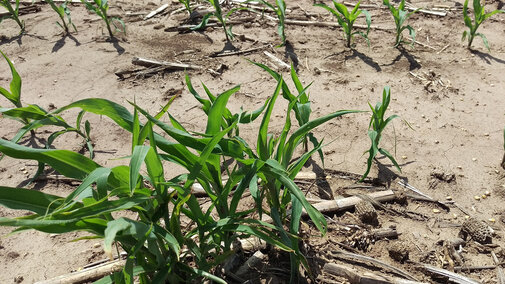

Wind storms last fall led to downed corn in many areas of the state. These losses, along with harvest losses, are contributing to widespread problems with volunteer corn in crop fields (Figure 1). This is despite grower efforts to manage the impending problem through post-harvest grazing and tillage of the fields. Depending on density, this volunteer corn may reduce crop yield if not controlled. (See control recommendations for corn and soybean.)
Q: How much does volunteer corn impact crop yields?
A: Volunteer corn actually impacts soybean, dry bean, and sugarbeet yields more than corn yields. This is perhaps due to the different growth structure of soybean, dry bean, and sugarbeet compared to corn. To envision the densities mentioned below, assuming 30" rows, 1/1000 of an acre is 17'5". Thus densities of 3500, 5000, and 7000 plants/acre would result in 3.5, 5, and 7 volunteer corn plants respectively in 1/1000 of an acre (17'5").
Soybean
- UNL research found a volunteer corn density of 3500 plants/acre led to 10% yield reduction in soybean. Doubling the density to 7000 plants/acre led to a 27% yield reduction.
- South Dakota State University data revealed similar trends. A volunteer corn density of 5000 plants/acre resulted in a 20% yield reduction (12 bu/acre yield loss in 60 bu/ac soybean).
- Clumps of volunteer corn in soybean (Figure 3) led to greater yield loss as they were more competitive than individual plants. In the UNL study a density of 3500 clumps of corn/acre resulted in a 40% yield reduction.
- Researchers in Minnesota and Illinois also found increased competition with clumps of volunteer corn versus individual plants. Clumps of corn (7-10 plants/clump) were established at different densities. Depending on the location and year, soybean yield was reduced 1% for every 75-115 clumps/acre.
- A recent UNL research study found highest yield reduction occurred when volunteer corn was left uncontrolled or when it was controlled too late at the R2 soybean growth stage. The combined density at this greatest yield reduction was at 24,710 volunteer corn plants per acre plus 1,235 volunteer corn clumps per acre.
Corn
- UNL research found a volunteer corn population of 3500 plants/acre resulted in a 2% yield reduction in corn. Doubling the density to 7000 plants/acre caused a 5% yield reduction.
- Clumps of volunteer corn led to greater yield loss as they were more competitive than individual plants. A density of 7000 clumps of corn/acre resulted in a 14% yield loss compared to a 5% yield loss with individual plants.
Dry Bean
- UNL research found dry bean yields were reduced 45% with a volunteer corn population of 5000 plants/acre.
Sugarbeet
- University of Wyoming research found a 51% yield reduction in sugarbeet with a volunteer corn population of 3500 plants/acre.
References
Alms, J., M. Moechnig, D. Deneke, D. Vos. 2008. Volunteer corn effect on corn and soybean yield. North Central Weed Science Society, Abstracts Volume 63.
Andersen, R.N., J.H. Ford, W.E Lueschen. 1982. Controlling volunteer corn (Zea mays) in soybean (Glycine max) with diclofop and glyphosate. Weed Science 30:132-136.
Beckett, T.H. and E.W. Stoller. 1988. Volunteer corn (Zea mays) interference in soybeans (Glycine max). Weed Science 36:159-166.
Chahal P.S. and A.J. Jhala. 2016. Effect of glyphosate-resistant volunteer corn density, control timing, and late season emergence on soybean yield. Crop Protection 81:38-42.
Wilson, R., R. Klein, M. Bernards, S. Knezevic. 2009. Volunteer Corn in Soybeans, Dry Beans, Sugarbeets, and Corn. 2009 Crop Production Clinic Proceedings p.154-156.

